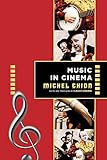Music in Cinema / Michel Chion.
Material type: TextSeries: Film and Culture SeriesPublisher: New York, NY : Columbia University Press, [2021]Copyright date: 2021Description: 1 online resourceContent type:
TextSeries: Film and Culture SeriesPublisher: New York, NY : Columbia University Press, [2021]Copyright date: 2021Description: 1 online resourceContent type: - 9780231198882
- 9780231552851
- 781.5/4209 23
- online - DeGruyter
| Item type | Current library | Call number | URL | Status | Notes | Barcode | |
|---|---|---|---|---|---|---|---|
 eBook
eBook
|
Biblioteca "Angelicum" Pont. Univ. S.Tommaso d'Aquino Nuvola online | online - DeGruyter (Browse shelf(Opens below)) | Online access | Not for loan (Accesso limitato) | Accesso per gli utenti autorizzati / Access for authorized users | (dgr)9780231552851 |
Frontmatter -- CONTENTS -- Translator’s Note -- Preface -- INTRODUCTION: MUSIC REDEFINED BY CINEMA -- PART I: HISTORICAL PERSPECTIVES -- 1. DREAMS AND REALITIES: 1895– 1935 -- 2. CLASSICISM TO MODERNISM: 1935– 1975 -- 3. BACK TO THE FUTURE: 1975– 1995 -- 4. WHITHER FILM MUSIC? 1996– 2020 -- PART II: THE THREE FACES OF MUSIC IN CINEMA -- 5. MUSIC AS ELEMENT AND MEANS -- 6. MUSIC AS WORLD -- 7. MUSIC AS SUBJECT, METAPHOR, AND MODEL -- BY WAY OF CONCLUSION -- Glossary -- Notes -- Index -- FILM AND CULTURE
restricted access online access with authorization star
http://purl.org/coar/access_right/c_16ec
Michel Chion is renowned for his explorations of the significance of frequently overlooked elements of cinema, particularly the role of sound. In this inventive and inviting book, Chion considers how cinema has deployed music. He shows how music and film not only complement but also transform each other.The first section of the book examines film music in historical perspective, and the second section addresses the theoretical implications of the crossover between art forms. Chion discusses a vast variety of films across eras, genres, and continents, embracing all the different genres of music that filmmakers have used to tell their stories. Beginning with live accompaniment of silent films in early movie houses, the book analyzes Al Jolson’s performance in The Jazz Singer, the zither in The Third Man, Godard’s patchwork sound editing, the synthesizer welcoming the flying saucer in Close Encounters of the Third Kind, and the Kinshasa orchestra in Felicité, among many more. Chion considers both original scores and incorporation of preexisting works, including the use and reuse of particular composers across cinematic traditions, the introduction of popular music such as jazz and rock, and directors’ attraction to atonal and dissonant music as well as musique concrète, of which he is a composer.Wide-ranging and original, Music in Cinema offers a welcoming overview for students and general readers as well as refreshingly new and valuable perspectives for film scholars.
Mode of access: Internet via World Wide Web.
In English.
Description based on online resource; title from PDF title page (publisher's Web site, viewed 20. Nov 2024)


